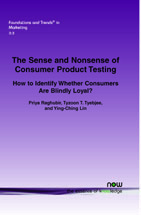The Sense and Nonsense of Consumer Product Testing: How to Identify Whether Consumers Are Blindly Loyal?
By Priya Raghubir, Professor and Mary C. Jacoby Faculty Fellow, Stern School of Business, New York University, USA, raghubir@stern.nyu.edu | Tyzoon T. Tyebjee, Professor of Marketing, Leavey School of Business, Santa Clara University, USA | Ying-Ching Lin, Associate Professor, National Dong Hwa University, ROC, yclin@mail.ndhu.edu.tw
Abstract
This paper builds on recent research that shows that product experience is based on the interaction of a range of sensory cues whose effect is non-conscious (e.g., visual cues affect taste perception) to revisit the classic issue of product taste testing. We propose that as consumers are unaware of the influence of a range of stimuli on their judgments and experience it is difficult for managers to collect valid and reliable consumer insights regarding the manner in which perceptual and sensory cues affect judgments and how they interact with each other. Therefore, we propose that the methodological paradigm of taste testing can and should be used to examine the effect of strategic and tactical marketing mix decisions in domains when consumer decision-making is non-conscious. Based on previous academic research, specific directions for managers to execute the test are provided: How to design and conduct a taste test, what measures to include and why, and how to analyze taste test results. We provide an example of the insight the methodology can provide using three related taste tests. While we use the attribute of taste as a specific example, the methodology and results can be translated into other domains where consumers may not be able to accurately explicate the reasons for their product experience, but that drive marketing decisions, including and beyond changing intrinsic product attributes.
The Sense and Nonsense of Consumer Product Testing
The Sense and Nonsense of Consumer Product Testing reviews the classic issue of product taste testing based on recent advancements made in psychology, neuroscience, and marketing, on how sensory cues affect product judgments. The authors: examine the implications that the five different sensory modalities (the olfactory, auditory, tactile, gustatory and visual systems) interact with each other, rather than exert independent influences, to define a customer's experience; propose that since consumers are unaware of the influence of a range of stimuli on their judgments and experience, they cannot explicate them, creating methodological challenges for managers to collect valid and reliable consumer insights regarding the consumers' experience; propose that the methodological paradigm of taste testing can be used to examine the effect of strategic and tactical marketing mix decisions. The goal of this monograph is to use the taste-test as a paradigm to understand how consumers make a range of sensory decisions combining intrinsic product information with the information available in the environment – specifically the research testing context. The Sense and Nonsense of Consumer Product Testing yields reliable insights for managers that would be elusive using standard survey techniques, and adds to the nascent, but growing, literature in marketing on how sensory product experience is multi-modal.
